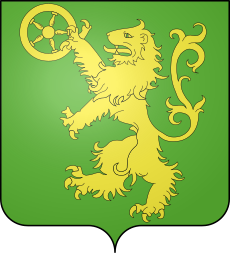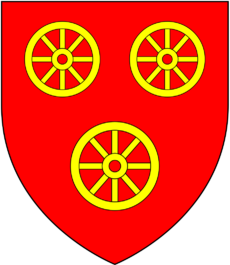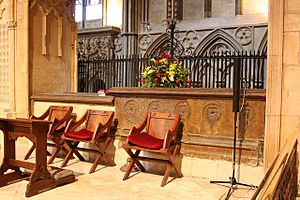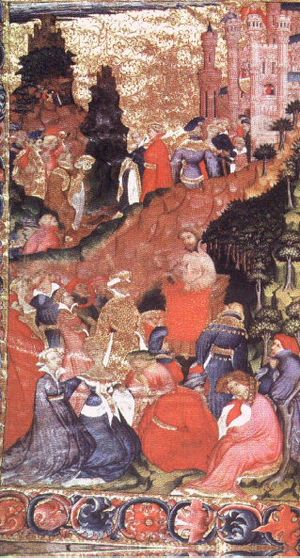Katherine Swynford facts for kids
Quick facts for kids Katherine Swynford |
|
|---|---|
| Duchess of Lancaster | |
| Born | Katherine de Roet c. 1349 County of Hainaut (possibly) |
| Died | 10 May 1403 (aged 52–53) Lincoln, Lincolnshire, Kingdom of England |
| Burial | Lincoln Cathedral |
| Spouse |
Hugh Swynford
(m. 1362; died 1371) |
| Issue |
|
| House | Lancaster (by marriage) |
| Father | Payne de Roet |
Katherine Swynford (born Katherine de Roet, around 1349 – 10 May 1403) was a very important woman in English history. She became the third wife of John of Gaunt, who was the Duke of Lancaster. John of Gaunt was also the fourth son of King Edward III.
Katherine was the daughter of a knight from a place called Hainaut. She grew up at the English royal court. Later, she worked for Blanche of Lancaster, who was John of Gaunt's first wife. At that time, Katherine was married to Hugh Swynford, one of the Duke's knights. After Blanche died, Katherine became a lady-in-waiting for Blanche's daughters and helped care for them.
After Hugh Swynford died, Katherine continued to work for the Duke's new wife, Constance of Castile. She was also given the job of managing her late husband's lands in Lincolnshire. Soon, she and John of Gaunt had a close relationship. They had at least four children together. These children were given the last name Beaufort. The Church later officially recognized these children.
John of Gaunt also gave Katherine several estates and a good amount of money. In 1381, their relationship caused some talk, so the Duke decided to end it for a while. Katherine then moved to a rented house in Lincoln.
Even after their formal break, Katherine remained friendly with John of Gaunt and his family. In 1387, King Richard II made her a Lady of the Garter. This was a very high honor. Soon after, she joined the household of Mary de Bohun. Mary was the wife of Henry Bolingbroke, who was John of Gaunt's eldest son. Henry later became King Henry IV.
In the early 1390s, Katherine and John of Gaunt became close again. After his second wife died, the Duke surprised many by marrying Katherine in 1396. This made some of the English nobles unhappy. However, a special paper from the Pope soon arrived. It said their marriage was valid and that all their children were legitimate. After the Duke died in 1399, Katherine went back to her house in Lincoln. She died there four years later and was buried at Lincoln Cathedral.
Katherine and John of Gaunt's children, the Beaufort family, played a big part in the Wars of the Roses. Henry VII, who became King of England in 1485, was related to them through his mother, Margaret Beaufort. She was a great-granddaughter of John of Gaunt and Katherine Swynford. This means Katherine is an ancestor of all English (and later British) kings and queens since Edward IV.
Contents
Katherine Swynford's Family History
Katherine's father was Paon de Roet. He was a herald and later a knight. He came to England with Queen Philippa, who married King Edward III. His family name was Roe (or Roët). Some people think he was related to a powerful family called the Lords of Le Roeulx from Hainaut. Their family name was spelled similarly.
Historian Alison Weir has some doubts about this. A writer named Jean Froissart, who was also from Hainaut, knew Paon. But he never said Paon was from a noble family. However, the names are very similar, and Paon's baptism name, Gilles, was common in the Le Roeulx family.
Another clue is that Paon's family coat of arms was similar to the Le Roeulx family's. The city of Le Rœulx had a golden lion holding a wheel on its coat of arms. Katherine Swynford's coat of arms had three gold wheels on a red background. This might show a family connection.
Paon de Roet was a King of Arms for a time in Aquitaine. In England, he worked for Queen Philippa. He fought in the Hundred Years' War, including the Battle of Crécy. He returned to Hainaut around 1349.
We don't know much about Katherine's mother. Some say Paon de Roet was married twice. Alison Weir believes he had two children from his first wife: Isabel (or Elizabeth) and Walter. Katherine and her sister Philippa (who married the famous poet Geoffrey Chaucer) were likely from his second wife.
Katherine's Early Life
We don't know exactly when Katherine was born. Historians think she was born around 1349 or 1350. This is based on when she first married and had her first child. Girls usually married around 12 years old back then. She was probably named after Saint Catherine of Alexandria.
Katherine was likely born in the County of Hainaut. This is what some old writers said. Her father probably brought his family to England around 1351. This was because things were uncertain in Hainaut at the time.
Katherine and her sisters probably stayed in England. They were cared for by Queen Philippa. The Queen was a kind and wise woman. She had many children of her own and also raised children from other noble families. Katherine likely received a good education at the royal court. She learned court manners and how to manage a household. She also learned English.
Katherine was probably raised with the Queen's younger children. A writer named Jean Froissart said that Blanche of Lancaster was Katherine's tutor. Blanche was John of Gaunt's first wife. Katherine and Blanche were close friends. Katherine's good education helped her later when she cared for Blanche's daughters.
Katherine's First Marriage
In the 1360s, Katherine worked for Blanche of Lancaster, who was now married to John of Gaunt. Katherine married Hugh Swynford around 1361 or 1362. Hugh was a soldier and worked for the Duke of Lancaster.
Hugh Swynford was not very rich. He owned two estates in Lincolnshire: Coleby and Kettlethorpe. His main money came from working for the Duke. Kettlethorpe became Katherine's main home for many years. She was often called "Lady Kettlethorpe."
Katherine and Hugh had several children. Their oldest daughter was probably Blanche, born around 1363. John of Gaunt was Blanche's godfather. Another daughter, Margaret, was born around 1364 and became a nun. Some historians think they had another daughter, Dorothy, born around 1366. They also had a son, Thomas, born in 1367.
Hugh Swynford was often away fighting in wars in France and Spain. Katherine managed their home, Kettlethorpe. She also continued to serve Duchess Blanche. Katherine likely helped care for the Duke's children.
Duchess Blanche died in 1368. Katherine, along with other ladies, attended her funeral. After Blanche's death, Katherine's life changed. She was highly valued by the Duke. She got along well with his children. So, she stayed to help care for them.
In 1371, Hugh Swynford died in Aquitaine.
Life with John of Gaunt
After her husband died, Katherine faced financial difficulties. But John of Gaunt helped her. In 1372, Katherine was present when Duchess Constance gave birth to her first child. Katherine was chosen to tell the King about his new granddaughter. This shows how important she was.
Katherine and her sister, Philippa Chaucer, moved to Hertford Castle. This is where the Duke's children lived. Katherine likely helped care for the Duke's children, whom she knew well.
Between 1373 and 1381, Katherine had at least four children with John of Gaunt. Their first son was John, born in late 1372 or early 1373. He was named after his father. The children were given the last name Beaufort. This name might come from Beaufort Castle in France. John was likely born in Lincoln.
By 1373, Katherine was living at the Duke's home, Savoy Palace. John of Gaunt made her the governess for his daughters, Philippa and Elizabeth. This gave her a good reason to live in the Duke's household. She had good skills for caring for children.
In 1374, John of Gaunt gave Katherine a gift of £25. By 1376, she was in charge of his daughters' household. She also received money to cover their expenses.
In 1376, John of Gaunt gave Katherine the right to marry off a young heir to her eldest daughter, Blanche Swynford. This suggests he planned for Blanche to marry this heir. However, Blanche likely died young.
Katherine had her second son with John of Gaunt around 1375. This was Henry Beaufort. He was named after John of Gaunt's father-in-law, Henry of Grosmont. Henry Beaufort later became a powerful Cardinal.
Around 1377, their daughter Joan Beaufort was born. She was probably named after the Dowager Princess of Wales, Joan of Kent. Joan was likely born at Pleshey Castle. John of Gaunt's legitimate children seemed to get along well with Katherine's children.
Katherine became quite wealthy after receiving more estates from John of Gaunt. These included Gringley, Wheatley, Waddington, and Wellingore.
A Formal Break and Return
In 1381, John of Gaunt decided to officially separate from Katherine. This was because their relationship was causing public disapproval. Katherine left the Duke's household. She received a yearly payment of £200. She moved to Lincoln and rented a house there.
However, their separation was only formal. Katherine remained friendly with John of Gaunt and his family. She even lent him money in 1386. In 1387, King Richard II made her a Lady of the Order of the Garter. This was a very high honor for a woman. It showed that the King recognized her special connection to John of Gaunt.
In 1387, Katherine and her daughter Joan Beaufort joined the household of Mary de Bohun, Henry Bolingbroke's wife. Katherine helped care for their children, including the future King Henry V.
In 1389, John of Gaunt returned to England. Their relationship likely started again around 1391. The Duke began to plan for the future of their children. Their son Henry Beaufort started working for the church. Their son John Beaufort became a knight and fought in battles. Their daughter Joan Beaufort married Robert Ferrers of Wem. John Beaufort also married Margaret Holland.
Becoming Duchess of Lancaster
On 24 March 1394, Constance of Castile, John of Gaunt's second wife, died. After this, the Duke decided to marry Katherine. He wanted to make their children legitimate.
Their marriage took place at Lincoln Cathedral on 13 January 1396. Katherine became the Duchess of Lancaster. She was a very important lady in the kingdom. To show her new status, she changed her coat of arms. It now had three gold Catherine wheels. This showed her devotion to Saint Catherine, her patron saint.
This marriage caused some concern among the nobles. They thought it was not a suitable match. John of Gaunt asked the Pope for official permission for their marriage. On 1 September 1396, Pope Boniface IX declared their marriage valid. He also made their children, the Beauforts, legitimate.
The legitimization helped the Beaufort children in their careers. Their daughter Joan Beaufort married Ralph Neville. In February 1397, King Richard II officially confirmed the Beauforts' legitimacy. John Beaufort became the Earl of Somerset. Katherine also gained control over some estates. Their youngest son, Thomas Beaufort, received awards. Henry Beaufort became a Bishop.
Katherine was often at court during the first 18 months of her marriage. She held a high position.
John of Gaunt's health got worse in his last years. His son, Henry Bolingbroke, had problems with King Richard II. Henry was sent away from England. This made the Duke's illness worse.
John of Gaunt died on 3 February 1399. He left Katherine many valuable things in his will.
Katherine's Last Years
After John of Gaunt died, the King's officials wrongly took Katherine's possessions. She had to ask King Richard II to return them. The King ordered her estates to be given back. He also confirmed that she would receive a yearly payment of £1,000 from the Duchy of Lancaster.
King Richard II then sent Henry Bolingbroke away from England for life. He also took Henry's lands. Katherine did not protest this. She moved to Lincoln and rented a house. She gave her estates of Kettlethorpe and Colby to her son, Thomas Swynford.
In 1399, Henry Bolingbroke returned to England. He removed King Richard II from the throne and became King Henry IV. Katherine's children, the Beauforts, and her son Thomas Swynford supported the new King. King Henry IV officially called Katherine "the Mother of the King." Katherine lived a quiet life in Lincoln. She did not take part in politics.
King Henry IV gave Katherine more land and money. She became a very rich woman. She owned houses in several towns. She might have also been involved in the wool trade.
Death and Burial
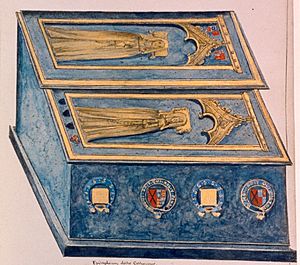
Katherine Swynford died on 10 May 1403 in Lincoln. She was buried at Lincoln Cathedral. Her tomb was made of marble. It had shields with coats of arms. A brass image of Katherine in a widow's dress was on top. Her epitaph said: "Here lies Lady Katherine, Duchess of Lancaster, wife of the very noble and very gracious Prince John, Duke of Lancaster... who died 10 May in the year of grace 1403."
Her daughter, Joan Beaufort, was buried next to her mother. Joan wanted her mother's burial place to be made larger. A chapel was set up at Lincoln Cathedral for prayers near her grave.
In 1644, during the English Civil War, Katherine's tomb was partly damaged. The metal parts were torn off. The stone work was also hurt. Today, the tombs are still there. They are close to each other. Katherine's tomb still shows where the shields used to be.
Katherine's Legacy
After Henry IV became King, Katherine Swynford's children from John of Gaunt became very important in English politics. In 1407, the King confirmed that the Beauforts were legitimate. However, he added a rule that they could not claim the English throne.
Katherine's granddaughter, Cecily Neville, married Richard of York, 3rd Duke of York. Their sons became Kings Edward IV and Richard III. Another granddaughter, Joan Beaufort, married King James I of Scotland. She became an ancestor of later Scottish kings.
Another descendant of Katherine, Margaret Beaufort, was the mother of King Henry VII. He was the first king of the House of Tudor. He used his connection to the Beaufort family to claim the throne. So, Katherine Swynford became a direct ancestor of all future Kings and Queens of England and Great Britain.
The Beaufort family played a big role in the Wars of the Roses. Even though the main male line of the Beauforts ended, a side branch continued. Today, the head of this family is the Duke of Beaufort. This title was created in 1682. It recognized their link to King Edward III through Katherine Swynford and John of Gaunt.
Katherine's son from her first marriage, Thomas Swynford, also had a career at King Henry IV's court. He was one of the jailers of the removed King Richard II. Thomas Swynford died in 1432. His family line eventually ended in 1498.
What Katherine Looked Like
An old description of Katherine from John of Gaunt's tomb said she was "extraordinarily beautiful and feminine." This description was added later by King Henry VII, who was her descendant. He wanted to make her reputation better.
There are no real portraits of Katherine from her lifetime. A sketch from the 1600s shows her in a widow's dress. It's not a true portrait. Some small carvings in Canterbury Cathedral are thought to be John of Gaunt and Katherine. But this is not certain.
John of Gaunt had a long, thin face. Katherine's children had round or oval faces. This might have come from her.
A drawing from an early 1400s book shows the poet Geoffrey Chaucer reading to the royal court. Some people think one of the women in the drawing is Katherine Swynford. She is shown with a round face, high forehead, and blonde hair. However, the drawing was made after the poem was written. The woman in the blue dress might be too young to be Katherine. Historian Alison Weir thinks it might be Katherine's daughter, Joan Beaufort. Weir also thinks another lady in the drawing might be Katherine.
If Alison Weir is right, Katherine was fair-haired and well-built. She had a narrow waist, wide hips, a long neck, and a round face. Her hair was styled high with a golden crown. This showed her high position.
Katherine's Personality
Writers from monasteries often criticized Katherine. They were shocked by her relationship with John of Gaunt. However, some writers who might have met her did not say anything bad.
Historian Alison Weir believes Katherine was "an attractive, charming and sympathetic woman, quite pious." Her long relationship with John of Gaunt suggests she was loyal to him. She was also likely strong and smart. Katherine valued her family. She cared about what others thought of her.
The respect she received from the royal family shows she was good at court duties. She likely had good taste, was friendly, polite, and intelligent. She was probably a good conversationalist.
Katherine's Coat of Arms
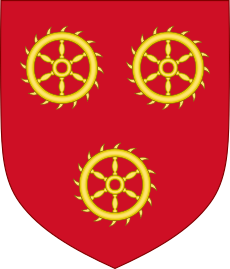
Before she married John of Gaunt, Katherine's coat of arms had three silver wheels on a red background. She likely inherited this from her father.
After her marriage in 1396, Katherine changed her coat of arms. It now had three gold Catherine wheels on a red background. The wheel symbol showed her devotion to her patron saint, Catherine of Alexandria. Saint Catherine was also linked to royalty and goodness.
Katherine in History and Art
Some people think Katherine might have been the inspiration for the character Virginia in Geoffrey Chaucer's story, "The Physician's Tale."
For many years, Katherine Swynford was not seen in a good light. People thought she was immoral. She was rarely mentioned as an ancestor of the House of Tudor. But interest in her grew in 1954. This was when Anya Seton published her book, Katherine.
Seton's book told Katherine's story in detail. She spent four years researching it. The book made people feel more sympathetic towards Katherine. It has been reprinted many times. In 2003, it was ranked 95th in a BBC survey of popular books.
Other books about Katherine have been published since then. These include Jeannette Lucraft's Katherine Swynford: The History of a Medieval Mistress (2006). Historian Alison Weir also wrote a detailed biography called Katherine Swynford: The story of John of Gaunt and his Scandalous Duchess (2007).
Katherine's Children
Katherine had children with Sir Hugh Swynford:
- Blanche Swynford (around 1363 – around 1375).
- (?) Margaret Swynford (around 1364 – ?), a nun in 1377.
- (?) Dorothy Swynford (around 1366 – ?), married Thomas Thymelby.
- Sir Thomas [II] Swynford (4 February 1367 – 2 April 1432), owned Colby and Kettlethorpe.
Katherine had children with John of Gaunt:
- John Beaufort (around 1372/1373 – 16 March 1410), became the 1st Earl of Somerset. He was officially recognized in 1397.
- Henry Beaufort (around 1375–1447), became a Bishop and later a Cardinal. He was officially recognized in 1397.
- Joan Beaufort (around 1377 – 13 November 1440), married Robert Ferrers and then Ralph Neville. She was officially recognized in 1397.
- Thomas Beaufort (around January 1381 – 27 December 1426), became the 1st Earl of Dorset and 1st Duke of Exeter. He was officially recognized in 1397.
See also
 In Spanish: Catalina de Roet-Swynford para niños
In Spanish: Catalina de Roet-Swynford para niños


